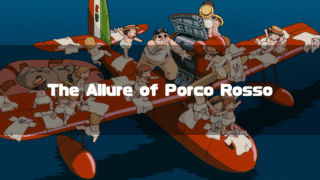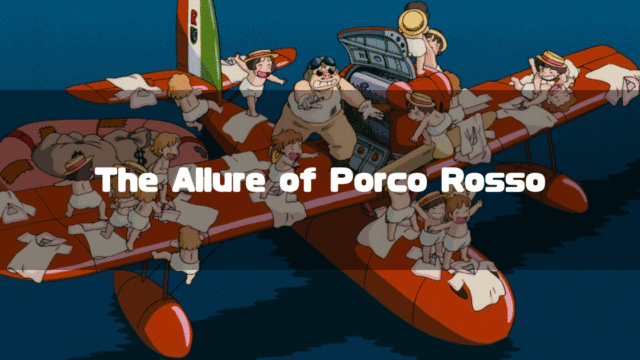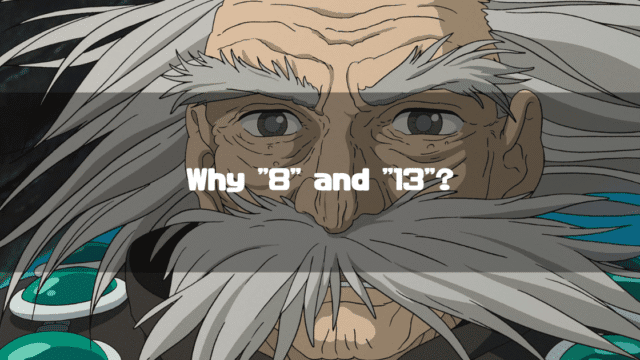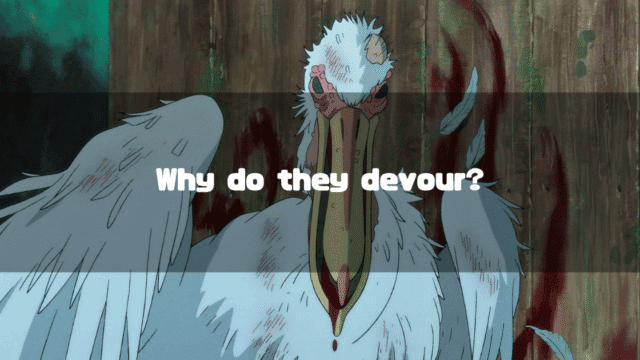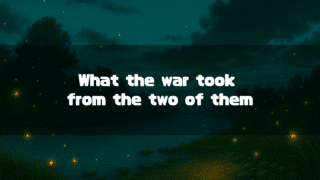Porco Rosso(Studio Ghibli Official) is a 1992 animated feature film directed by Hayao Miyazaki.
I’ve watched this film countless times since I was a child, and it’s the kind of work where I discover something new with each viewing. This time, I want to focus my thoughts on Madame Gina.
In the film, Gina says the following:
“I’d lost three pilot husbands already. One is combat, one in the Atlantic. The third died in Asia”
(Original Texs, in Japanese)
「私は三回飛行艇乗りと結婚したけど、一人は戦争で、一人は大西洋で、最後の一人はアジアで死んだって。」
Seeing the air pirates and Curtis, it’s clear that Gina is a very popular woman. I imagine she married pilots because she was always surrounded by them.
However, the problem is the order. She chose the Great War hero Porco Rosso (or Marco Pagot, to be precise) as her fourth partner.
Porco Rosso appears as a fat pig, but he was a handsome man in his youth, so there seems to be no particular reason for him to be the fourth. And, if Gina thought of Porco as nothing more than her fourth man, she probably wouldn’t have rejected Curtis’s passionate marriage proposal.
If you watch it normally, you probably wouldn’t question Gina’s judgment. But as someone who has seen Porco Rosso many times, I start to think about strange things.
In the following article, I will try to articulate the reason why Gina gave Curtis the cold shoulder and explore her inner self. Why did Gina finally choose Porco as her fourth and reject Curtis’s proposal?
First, let’s think about Gina’s past three marriages.
*This article is an English translation of the original Japanese article, 【紅の豚】マダム・ジーナは何故ドナルド・カーチスを袖にしたのか-過去3回に渡る結婚の謎を考察-.
Let an AI walk you through the highlights of this post in a simple, conversational style.
- Gina’s Marriages in Order of “Good Guys” (Order of Controllability)
The kind of men who fly seaplanes are basically “rogues” and hard to handle, but she chose them in the order of men she could control: childhood friends who had a track record of fawning over her. - Similarities and Differences Between Curtis and Porco
Curtis, being a skilled pilot, is an “uncontrollable rogue” that Gina cannot dominate. Porco (Marco), on the other hand, is the most free and uncontrollable, but he had a history of adoring Gina since they were young, making him the one she decided to love as a “final bet” if he came to her garden. - The Homage to Saint-Exupéry Hidden in “the Atlantic” and “Asia”
Her two husbands who died after the war may have been mail pilots flying perilous routes. Based on real air routes like those of Aéropostale, it’s considered that Hayao Miyazaki projected the career of his beloved Saint-Exupéry onto the story, placing the deadly locations of “the Atlantic” and “Asia.”
The Reason Gina Rejected Curtis and Chose Porco Fourth

Who Did She Marry in Her Past Three Marriages, and in What Order?
Although not explicitly stated in the film, if we take the number “3” as a hint, I believe the three men Gina married are the ones in the photograph where Porco’s (Marco’s) face is crossed out.
I think we can infer the following about these three men:
- Gina, Porco, and the three men were childhood friends,
- They had been in love with Gina since they met,
- All three became seaplane pilots, but Porco was the most skilled,
- They were all “good guys.”
The last point, about them being “good guys,” can be slightly supported by Porco’s following statement:
“The good always get killed.”
(Original Text, in Japanese)
「いいやつは皆しんだ。」
Of course, this probably also refers to the people who died in the war, but considering this line comes right after Gina tells him about the death of her third husband, it’s natural to assume he is strongly thinking of the three men. After this, he says, “To friends,” and raises a glass with Gina.
And when we think this way, the biggest question is, “In what order did she marry them?”
Married in Order of “Good Guys” (Phase 1)
A hint for estimating the order of Gina’s marriages is the existence of Porco, who was finally chosen fourth; the union of air pirates, who are seen only as customers; and Curtis, whose passionate proposal was rejected.
What kind of guys are they, anyway?
Just when the First World War ended, the Great Depression hit, and the world was once again plunged into chaos. People are still desperately trying to live within that “situation,” but guys like Porco, the air pirates, and Curtis are beings who have escaped from it. In other words, from an outsider’s perspective, they would be seen as rogues.
Of course, we must not forget the scars of the First World War. At least the members of the air pirate union were likely people who were drafted into the war, so it’s understandable that they would choose a lifestyle of “I can’t deal with this world.” The same goes for those who didn’t become “rogues,” though.
It might be fine to have fun and date such men, but when it comes to marriage, it’s a different story. They probably wouldn’t stay home, and they might find other women. And they wouldn’t feel bad about it either.
Conversely, you could say that the men Gina thought were acceptable for marriage were “people who seemed capable of maintaining a married life,” and that she married them in that order. It’s rather obvious when you think about it, but considering this allows for a more interesting examination of the other two men who died after the war.
The “Rogues” are Better Pilots
Recalling Gina’s words, her first husband died in the war, but the remaining two survived it.
This means that the other two, while not as skilled as Porco, were good enough to survive the war. It’s likely that everyone who could fly a plane was mobilized, so there’s no particular problem with this line of thought.
I believe Gina ultimately married them in order of “good guys,” but it’s unclear what specific jobs her second and third husbands had. However, isn’t it likely they died in “the Atlantic” and then “Asia” because they never quit flying their seaplanes?
*I will discuss the jobs of these two men later in the section “Saint-Exupéry and Hayao Miyazaki,” but they were likely pilots carrying airmail.
Despite somehow surviving the harsh conditions of war, they simply could not give up flying. That’s likely how captivating the act of “flying” is to a pilot.
However, the issue I want to address here is “marriage.”
As a spouse, one would want them to stop flying. Indeed, it’s believed her two husbands died in plane crashes, which means their lives were constantly in danger. But they didn’t quit flying and lived as they pleased. In that context, they too were “rogues,” and perhaps that personality was inseparable from their excellent piloting skills.
Thinking about things through the lens of “marriage” up to this point, I also think, Then why not just stop marrying pilots! And her husbands who died after the war don’t seem like “good guys” at all.
This suggests that the truth of Gina’s inner world was a bit more complex.
Married in Order of “Good Guys” (Phase 2) – The Ideal of a Controllable “Rogue” –
I imagine many men throughout history have suffered from the sad reality that “bad boys (rogues) are popular.” There are probably various reasons for this, but what’s important for us is that it is a reality.
The same was probably true for Gina. She doesn’t seem to be depicted as someone who could love a peaceful, ordinary man.
On top of that, when considering “marriage,” a person worthy of marrying for Gina would be “a popular ‘rogue’ who, for some reason, only has eyes for you and, moreover, does what you say.” Come to think of it, it seems like all women might think this way, and this describes the kind of man who falls for the heroine in a shojo manga.
So, why did the men Gina married in the past appear to her as such beings?
- As childhood friends, they had always doted on her,
- They possessed skills as pilots,
- They were naturally popular with others,
- And they had a certain dangerousness, as if they might disappear at any moment.
I think these were the reasons. The most important thing seems to be “a certain dangerousness, as if they might disappear at any moment.” It’s important that despite this danger, they seem likely to stay by her side for some reason, and the basis for that belief was likely the fact that “they had doted on her as childhood friends.”
Even in the film, Gina is surrounded by seaplane pilots, and it feels like she had other choices besides the four including Porco. However, perhaps the fact that she had known them since she was young and already had the experience of them listening to what she said was a major factor.
In the end, didn’t Gina marry them in the “order of who seemed most likely to listen to her“? To put it another way, she married them in the order of “rogues she could control.” And when we think about it this way, the reason Curtis was rejected also becomes clear.
Why Was Curtis Rejected by Gina?
Curtis is a pilot with skills comparable to Porco’s, and considering he later became a successful actor, he’s popular and good-looking (though it’s hard to tell in the film).
However, if we consider that the more skilled a pilot is, the more of a rogue they are, it’s conceivable that Curtis is, in fact, not someone Gina can handle.
Watching the film, Gina seems more mature (and experienced), and Curtis appears to be skillfully handled by her. On the surface, that seems right, but if we assume the fact that Gina has only ever married (or dated) men who have doted on her since she was young, then perhaps the reason Curtis isn’t attractive to her is that “she can’t control him.”
And thinking this way, the reason Porco (Marco) was the last man also becomes clear.
The Reason Porco (Marco) Was Fourth
By now, the reason Porco was last should be clear. Gina said the following to Curtis:
“I’m gambling right now. Gamnbling somone will visit me here, and I’ll tel him I love him.”
(Original Text, in Japanse)
「私がこの庭にいるときにその人が訪ねて来たら、今度こそ愛そうってカケしているの」
It’s quite a condescending line, but based on what we’ve discussed so far, I believe the reason Porco was last is that “among the people she had known forever and who had doted on her, he was the most difficult to control.“
It’s not because his face is a pig’s, or because he was the least popular.
There aren’t many scenes in the film that reveal the truth of Gina’s inner world, so I think there are various ways to interpret her decisions, but this is one possible perspective.
Saint-Exupéry and Hayao Miyazaki – Investigating the Jobs of the Two Husbands Who Died After the War –

When discussing Porco Rosso, Hayao Miyazaki’s love for Antoine de Saint-Exupéry is impossible to ignore. Miyazaki’s feelings for Saint-Exupéry are detailed in the 1998 NHK broadcast “Journey of the Heart: Saint-Exupéry, a Dream of the Great Sky(世界・わが心の旅 サンテグジュペリ 大空への夢, in Japanese).”
This documentary follows Hayao Miyazaki as he traces the footsteps of Saint-Exupéry, famous as the author of The Little Prince, and it reveals the significant influence he had on Miyazaki. At the end of the documentary, Miyazaki, with tears in his eyes, said the following:
“In the end, it was Saint-Exupéry who influenced me the most.”
(Original Text, in Japanse)
「サンテグジュペリに一番影響を受けたんですよ僕は。結局。」
He was such a presence that this great film director declared he was “influenced the most” by him.
Saint-Exupéry’s life was fascinating, with a brief biography as follows:
| June 29, 1900 | Born in Lyon, France. Born into an aristocratic family, he showed an interest in literature and mechanics from an early age. |
|---|---|
| 1921 | Joined the French Air Force for military service. He received his first flight training while stationed in Morocco and obtained his pilot’s license. |
| 1926 | Began working as a mail pilot for Aéropostale (later Air France). He was in charge of the mail route between France and Africa, gaining experience under harsh conditions. |
| 1929 | Assigned to Argentina in South America, he worked as the head of the Buenos Aires branch. He also began to distinguish himself as a writer, drawing on his adventures as a pilot. |
| 1931 | Published the novel Night Flight and gained high acclaim as a writer. He went on to publish masterpieces such as Wind, Sand and Stars and The Little Prince. |
| 1939 | World War II broke out. He volunteered for reconnaissance flight missions. After the fall of France, he continued his writing activities in exile in places like the United States. |
| 1943 | Rejoined a reconnaissance squadron in North Africa. Although he was technically ineligible due to his age and health, he was specially permitted to fly missions. |
| July 31, 1944 | Went missing during a reconnaissance flight from a base in Corsica. The wreckage of his plane was later discovered off the coast of Marseille in southern France, confirming he was killed in action. |
The point I want to make here is about the mail pilots.
Mail pilots, as the name suggests, were pilots who transported mail by plane. Given the aircraft technology of the time, it was an extremely harsh job. In other words, many people risked their lives, facing the danger of crashing.
Weren’t Gina’s two ex-husbands who died after the war also these mail pilots? The most curious part about her husbands’ deaths was “Asia.”
Since the story is set in Italy, if one died in the Atlantic, you might think, “I suppose that’s possible.” But “Asia” is a different story. However, if we consider them to be mail pilots, it makes a certain amount of sense.
Before World War II, airlines from France, Britain, and Germany operated airmail services. France’s Latécoère had the Atlantic route from “Dakar -> Natal -> Rio de Janeiro,” Britain’s Imperial Airways had the Southeast Asia route from “London -> Singapore -> Australia,” and Germany’s Deutsche Luft Hansa had the Asia route from “Berlin -> Bangkok -> Hanoi -> Taipei” (each had several other routes as well).
In other words, if we consider that Gina’s two husbands were mail pilots, the story holds together.
Thinking this way, isn’t it possible that Hayao Miyazaki’s love for Saint-Exupéry was embedded in the locations of “the Atlantic” and “Asia”?
These are English Wikipedia links, but I am referencing the routes of Latécoère, Imperial Airways, and Deutsche Luft Hansa for the airmail routes.
About the Author
Recent Posts
- 2025-10-02
An Analysis of the Shōwa Godzilla’s Transformation: How Did Godzilla Become a Hero? - 2025-10-01
Godzilla(1954):Full Synopsis and Analysis: The “Sin” and “Destruction” Symbolized by Dr. Yamane and Dr. Serizawa - 2025-09-30
Godzilla (1954): Dr. Serizawa’s Love and His Suicide with the Monster - 2025-09-28
Princess Mononoke: What Did Ashitaka Mean by “The Forest Spirit Can’t Die. It Is Life Itself”? - 2025-09-27
E.T. The Extra-Terrestrial: Full Synopsis & Analysis: Why Did E.T. Collapse by the River and Come Back to Life?





